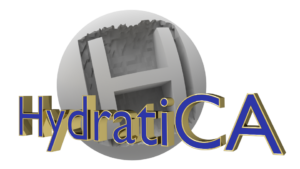 HydratiCA is a 3D kinetic cellular automaton model of mineral hydration, gelation, and microstructure evolution. It uses a collection of stochastic algorithms to simulate diffusive mass transport, advection, and coupled nonlinear reaction kinetic equations. Mass is discretized in small clusters of approximately 10-22 moles, and the net effects of forward and reverse elementary reactions, including homogeneous and heterogeneous reactions, adsorption, nucleation, and growth are simulated at nanometer length scales and millisecond to hour timescales. It has been used to examine possible rate-controlling mechanisms for the induction period of alite hydration, microstructure evolution during the production of slaked lime, the influence of time-dependent driving forces on kinetics, and to interrogate the development of spatial correlations among dissolving and precipitating silicate and aluminate minerals. The animation below shows a HydratiCA simulation of the dissolution of a CaO nanoparticle (20 nm diameter) to form Ca(OH)2 by heterogeneous nucleation and growth.
HydratiCA is a 3D kinetic cellular automaton model of mineral hydration, gelation, and microstructure evolution. It uses a collection of stochastic algorithms to simulate diffusive mass transport, advection, and coupled nonlinear reaction kinetic equations. Mass is discretized in small clusters of approximately 10-22 moles, and the net effects of forward and reverse elementary reactions, including homogeneous and heterogeneous reactions, adsorption, nucleation, and growth are simulated at nanometer length scales and millisecond to hour timescales. It has been used to examine possible rate-controlling mechanisms for the induction period of alite hydration, microstructure evolution during the production of slaked lime, the influence of time-dependent driving forces on kinetics, and to interrogate the development of spatial correlations among dissolving and precipitating silicate and aluminate minerals. The animation below shows a HydratiCA simulation of the dissolution of a CaO nanoparticle (20 nm diameter) to form Ca(OH)2 by heterogeneous nucleation and growth.
Software
Please contact us for opportunities to collaborate on developing or using HydratiCA. We are happy to make source code and user guides available for collaborative research.
Selected Publications
- JW Bullard, A three-dimensional microstructure model of reactions and transport in aqueous mineral systems, Modelling and Simulation in Materials Science and Engineering, 15 (2007) 711-738. DOI: 10.1088/0965-0393/15/7/002
- JW Bullard, Approximate rate constants for nonideal diffusion and their application in a stochastic model, Journal of Physical Chemistry A, 111 (2007) 2084-1092. DOI: 10.1021/jp0658391
- JW Bullard, A determination of hydration mechanisms for tricalcium silicate using a kinetic cellular automaton model, Journal of the American Ceramic Society, 91 (2008) 2088-2097. DOI: 10.1111/j.1551-2916.2008.02419.x
- JW Bullard, E Enjolras, WL George, SG Satterfield, JE Terrill, A parallel reaction-transport model applied to cement hydration and microstructure development, Modelling and Simulation in Materials Science and Engineering, 18 (2010) 025007. DOI: 10.1088/0965-0393/18/2/025007
- JW Bullard, RJ Flatt, New insights into the effect of calcium hydroxide precipitation on the kinetics of tricalcium silicate hydration, Journal of the American Ceramic Society, 93 (2010) 1894-1903. DOI: 10.1111/j.1551-2916.2010.03656.x
- JW Bullard, GW Scherer, JJ Thomas, Time dependent driving forces and the kinetics of tricalcium silicate hydration, Cement and Concrete Research 74 (2015) 26-34. DOI: 10.1016/j.cemconres.2015.03.016
